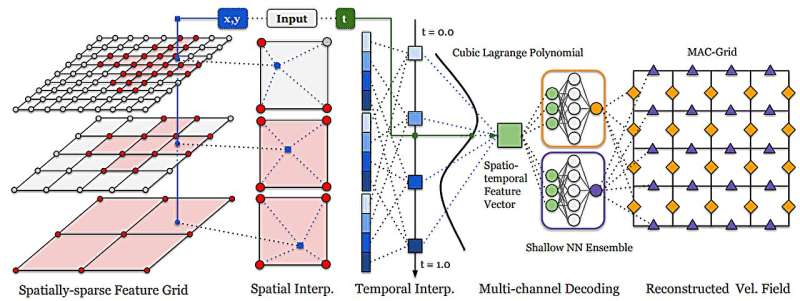This article has been reviewed according to Science X's editorial process and policies. Editors have highlighted the following attributes while ensuring the content's credibility:
fact-checked
peer-reviewed publication
trusted source
proofread
Researchers reach new AI benchmark for computer graphics

Computer graphic simulations can represent natural phenomena such as tornados, underwater, vortices, and liquid foams more accurately thanks to an advancement in creating artificial intelligence (AI) neural networks.
Working with a multi-institutional team of researchers, Georgia Tech Assistant Professor Bo Zhu combined computer graphic simulations with machine learning models to create enhanced simulations of known phenomena. The new benchmark could lead to researchers constructing representations of other phenomena that have yet to be simulated.
Zhu co-authored the paper "Fluid Simulation on Neural Flow Maps." The Association for Computing Machinery's Special Interest Group in Computer Graphics and Interactive Technology (SIGGRAPH) gave it a best paper award in December at the SIGGRAPH Asia conference in Sydney, Australia.
The paper is published in ACM Transactions on Graphics, and the full text can be accessed on the preprint server arXiv.
The authors say the advancement could be as significant to computer graphic simulations as the introduction of neural radiance fields (NeRFs) was to computer vision in 2020. Introduced by researchers at the University of California-Berkley, University of California-San Diego, and Google, NeRFs are neural networks that easily convert 2D images into 3D navigable scenes.
NeRFs have become a benchmark among computer vision researchers. Zhu and his collaborators hope their creation, neural flow maps, can do the same for simulation researchers in computer graphics.
"A natural question to ask is, can AI fundamentally overcome the traditional method's shortcomings and bring generational leaps to simulation as it has done to natural language processing and computer vision?" Zhu said. "Simulation accuracy has been a significant challenge to computer graphics researchers. No existing work has combined AI with physics to yield high-end simulation results that outperform traditional schemes in accuracy."
In computer graphics, simulation pipelines are the equivalent of neural networks and allow simulations to take shape. They are traditionally constructed through mathematical equations and numerical schemes.
Zhu said researchers have tried to design simulation pipelines with neural representations to construct more robust simulations. However, efforts to achieve higher physical accuracy have fallen short.
Zhu attributes the problem to the pipelines' incapability of matching the capacities of AI algorithms within the structures of traditional simulation pipelines. To solve the problem and allow machine learning to have influence, Zhu and his collaborators proposed a new framework that redesigns the simulation pipeline.
They named these new pipelines neural flow maps. The maps use machine learning models to store spatiotemporal data more efficiently. The researchers then align these models with their mathematical framework to achieve a higher accuracy than previous pipeline simulations.
Zhu said he does not believe machine learning should be used to replace traditional numerical equations. Rather, they should complement them to unlock new advantageous paradigms.
"Instead of trying to deploy modern AI techniques to replace components inside traditional pipelines, we co-designed the simulation algorithm and machine learning technique in tandem," Zhu said.
"Numerical methods are not optimal because of their limited computational capacity. Recent AI-driven capacities have uplifted many of these limitations. Our task is redesigning existing simulation pipelines to take full advantage of these new AI capacities."
In the paper, the authors state the once unattainable algorithmic designs could unlock new research possibilities in computer graphics.
Neural flow maps offer "a new perspective on the incorporation of machine learning in numerical simulation research for computer graphics and computational sciences alike," the paper states.
"The success of Neural Flow Maps is inspiring for how physics and machine learning are best combined," Zhu added.
More information: Yitong Deng et al, Fluid Simulation on Neural Flow Maps, ACM Transactions on Graphics (2023). DOI: 10.1145/3618392. On arXiv: DOI: 10.48550/arxiv.2312.14635


















